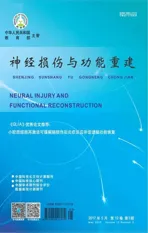Microglial repopulation resolves inflammation and promotes brain recovery after injury
2017-04-05RiceRAPhamLeeRJNajafiARWestBLGreenKN
Rice RA,Pham J,Lee RJ,NajafiAR,West BL,Green KN
·《GLIA》优秀论文推荐·
Microglial repopulation resolves inflammation and promotes brain recovery after injury
Rice RA1,Pham J1,Lee RJ1,NajafiAR1,West BL2,Green KN1
1.Department of Neurobiology and Behavior,Institute for Memory Impairments and Neurological Disorders, University of California,Irvine,California,92697.
2.Plexxikon Inc,Berkeley,California,94710.
Microglia mediate chronic neuroinflammation following central nervous system(CNS)disease or injury,and in doing so,damage the local brain environment by impairing recovery and contributing to disease processes.Microglia are critically dependent on signaling through the colony-stimulating factor 1 receptor(CSF1R)and can be eliminated via administration of CSF1R inhibitors.Resolving chronic neuroinflammation represents a universal goal for CNS disorders,but long-term microglial elimination may not be amenable to clinical use.Notably, withdrawal of CSF1R inhibitors stimulates new microglia to fully repopulate the CNS,affording an opportunity to renew this cellular compartment.To that end,we have explored the effects of acute microglial elimination,followed by microglial repopulation,in a mouse model of extensive neuronal loss.Neuronal loss leads to a prolonged neuroinflammatory response,characterized by the presence of swollen microglia expressing CD68 and CD45,as well as elevated levels of cytokines,chemokines,complement,and other inflammatory signals.These collective responses are largely resolved by microglial repopulation.Furthermore,microglial repopulation promotes functional recovery in mice,with elevated plus maze performance matching that of uninjured mice,despite the loss of 80%of hippocampal neurons.Analyses of synaptic surrogates revealed increases in PSD95 and synaptophysin puncta with microglial repopulation,suggesting that these cells sculpt and regulate the synaptic landscape.Thus,our results show that short-term microglial elimination followed by repopulation may represent a clinically feasible and novel approach to resolve neuroinflammatory events and promote brain recovery.
colony-stimulating factor 1 receptor;dendritic spines;glia;neuroinflammation;neuronal loss
(编译:唐颖馨)
摘 自《GLIA》2017, 65:931-944.
小胶质细胞再激活可缓解脑损伤后炎症反应并促进脑功能恢复
中枢神经系统疾病或损伤后,小胶质细胞介导的慢性神经炎症反应会损伤局部脑组织,加重病情,不利于神经功能的恢复。小胶质细胞的激活通过集落刺激因子1受体(CSF1R)信号通路,CSF1R抑制剂可阻断小胶质细胞的激活。抑制慢性神经炎症反应是治疗中枢神经系统疾病的有效方法,但长时间抑制小胶质细胞在临床实践中无法实现。值得注意的是,去掉CSF1R抑制剂可刺激中枢神经系统内新的小胶质细胞的彻底重激活。本课题组建立小鼠广泛性神经元丢失模型,在该模型中探讨急性小胶质细胞的消除及再激活的作用。神经元的丢失导致了较长时间的神经炎性反应,表现为小胶质细胞肿胀,并表达CD68和CD45;同时,细胞因子、趋化因子、补体及其他炎症信号的表达增加。小胶质细胞的再激活可以缓解上述炎症反应,还可以促进小鼠神经功能的恢复,即使该小鼠的海马神经元丢失80%,其在水迷宫测试中的得分与正常小鼠的得分相差无几。对突触的分析结果显示,小胶质细胞的再激活可增加PSD95和突触泡蛋白点状突触体的表达,提示小胶质细胞有助于重塑和调节突触的形态和功能。综上所述,本研究结果显示,小胶质细胞的短时间消除及再激活可能是一种新颖有效的方法用于减少神经炎性反应并促进脑功能恢复。
集落刺激因子1受体;树突棘;胶质细胞;神经炎症反应;神经元丢失
R741
ADOI10.16780/j.cnki.sjssgncj.2017.01.035
